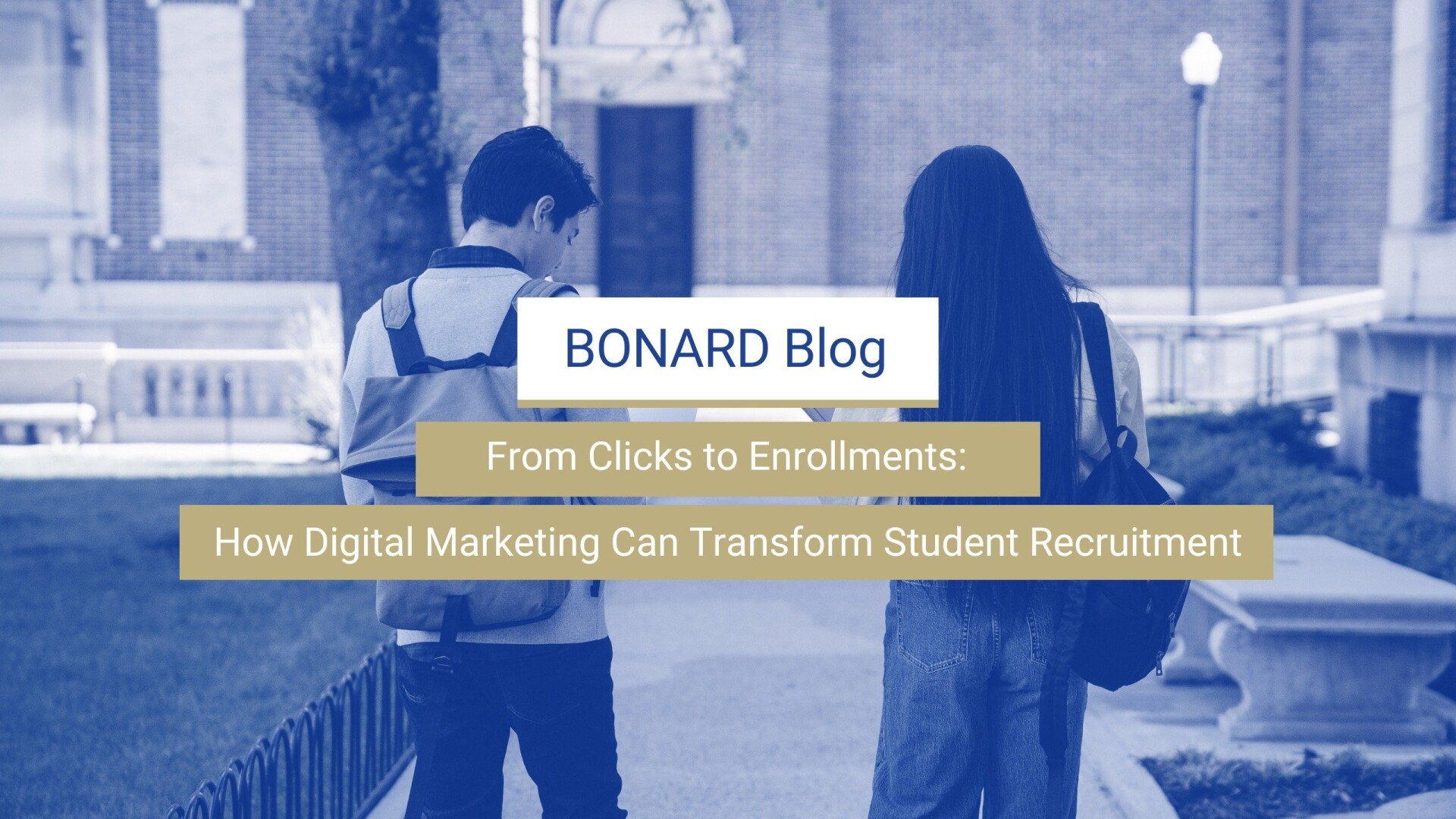To this end, BONARD recently hosted a webinar titled “Enhancing Student Recruitment with Digital Marketing” during which experts shared best practices for developing comprehensive digital marketing strategies for student recruitment. In this blog post, we provide insights that emerged from the webinar. So, let us dive in ⤵️
There are four essential stages to creating a successful digital marketing campaign:
1. Establishing the persona of the target audience
2. Devising a digital marketing strategy
3. Collecting leads
4. Converting leads into enrollments
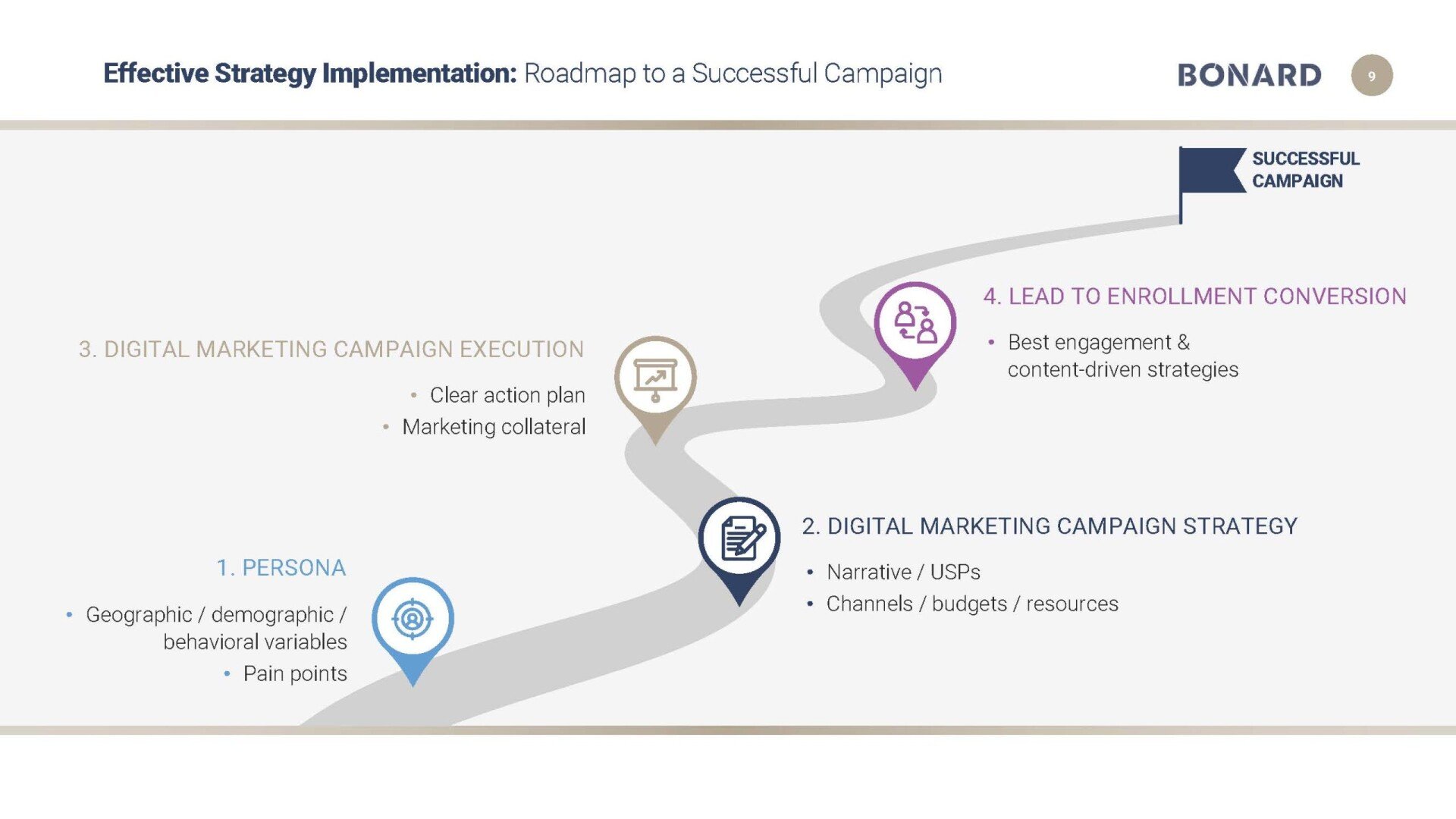 1. Establishing the persona of the target audience
1. Establishing the persona of the target audience
Identifying the target audience is an essential part of creating a digital marketing campaign for international student recruitment. To develop a clear picture of your ideal student, consider factors such as:
age
location
interests
academic background
Parents are sometimes the primary decision-makers and influencers, so you might tailor your campaign to meet the needs of both parents and prospective students.
By understanding your target audience, you can create a digital marketing campaign that pulls in both prospective students and their parents.
CASE STUDY #1
BONARD embarked on a mission to attract international K-12 students for a Canadian client. Their brand-awareness campaign targeted parents, the decision-makers, through compelling messages:
Addressing parents’ concerns about their child’s safety and well-being.
Highlighting academic and career opportunities.
The campaign got over 9 million impressions, igniting conversations and positioning Canada as an enticing educational destination.
2. Devising a digital marketing strategy
Crafting a successful digital marketing strategy involves understanding your audience, selecting fitting communication channels, and creating engaging narratives and landing pages. You must also consider the human element, manage your online reputation, and measure your campaign results. This section explores these crucial aspects and offers insights into developing an effective strategy for engaging and converting prospective international students.
Communication Channels
As outlined in the webinar, social media platforms are powerful tools for reaching prospective international students and their parents. Identify what platforms specific countries use most, then use them to share information about your institution, highlighting student success stories and engaging with prospective students through targeted advertising and messaging.
Create a Winning Landing Page
Creating engaging and informative content is key to attracting and retaining the attention of prospective international students. Consider producing videos, blog posts, and infographics that highlight the unique selling points of your institution, display student life, and provide useful information about the application process and campus resources.
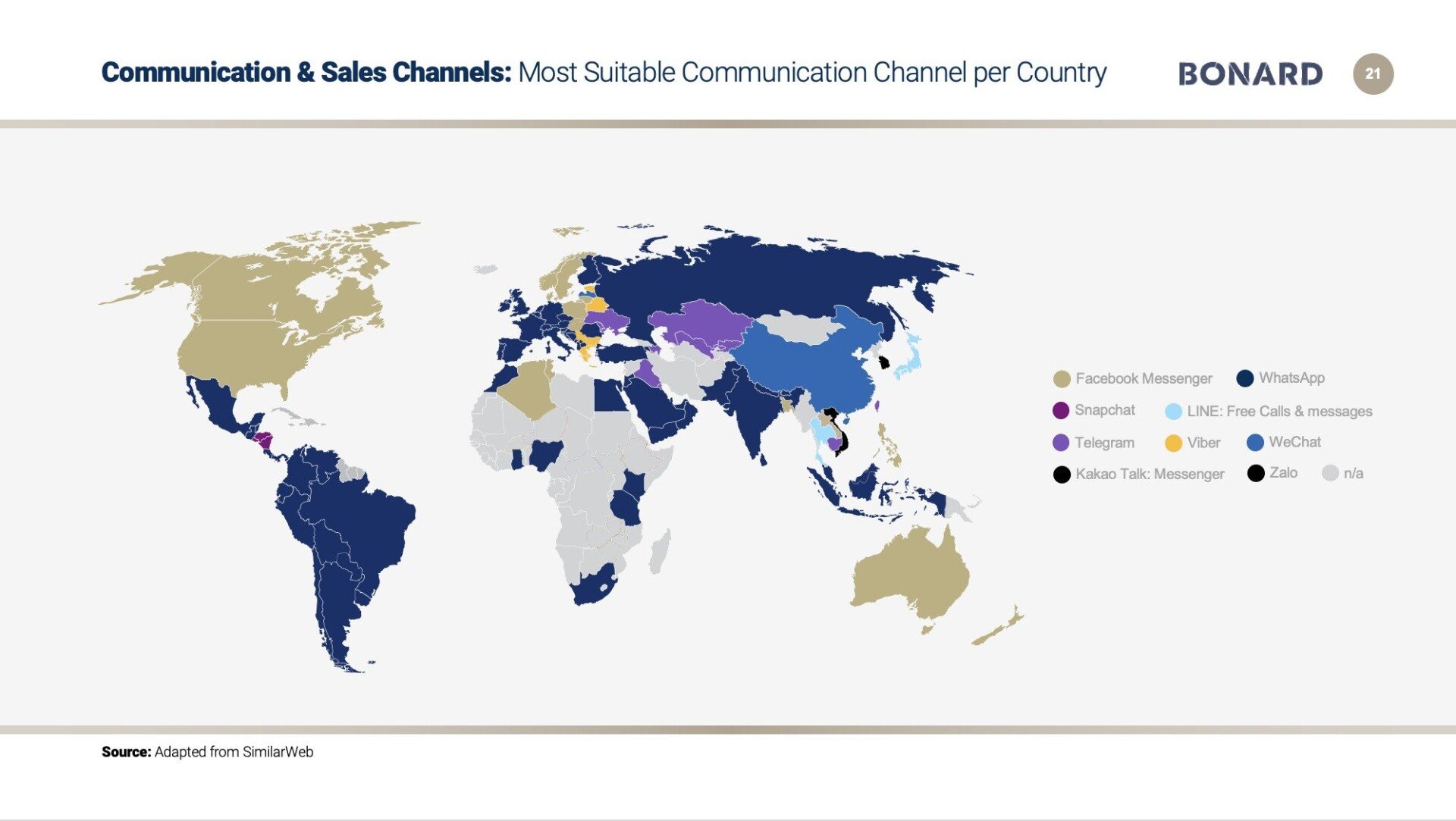 3. Collecting leads
3. Collecting leads
In addition to reaching prospective international students, it is important to collect leads and contact information so that you can follow them up. In addition to collecting basic information such as name, email, and phone number, gather other relevant information that will help in the enrolment process. For example, language level, age, and financial aid needs could be essential pieces of data that institutions may need to collect. This information can be included in the form that prospective students fill out to express interest in the program.
By collecting this information upfront, institutions can better understand the needs and preferences of their prospective students and use a data-driven approach to tailor their marketing efforts.
CASE STUDY #2
A prestigious university in the U.S. wanted to attract talented students from Brazil. BONARD created a targeted lead-generation campaign:
Using Instagram, the top communication channel for young people in Brazil.
Showcasing the university’s offerings through videos and reels.
Collecting leads via a landing page for future communication.
The campaign resulted in 1,174 leads from Brazil, with a low cost per click of 0.06 USD and cost per lead of 1.44 USD. Out of these leads, 352 were highly qualified prospects.
As a result, the university gained a strong pool of potential applicants and increased awareness among Brazilian students.
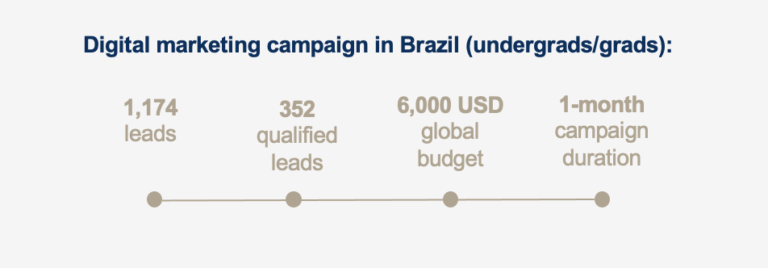 4. Converting leads into enrollment
4. Converting leads into enrollment
Once you have collected leads, it is important to develop a lead conversion journey to turn them into actual applicants. This may involve developing targeted follow-up campaigns, creating personalized messaging, and providing additional resources and support to help students navigate the application process.
Appealing landing page
One of the most important conversion factors in a digital marketing campaign is the landing page. Key elements in a winning landing page are:
A form tailored to the institution’s needs.
A clear call to action.
A sense of urgency to motivate immediate action.
Clear pricing information and easy payment terms, if applicable.
A strong narrative and unique selling proposition.
Program syllabus.
Testimonials from faculty members and students.
Opportunities for the prospective student to interact with a human.
Timely response
It is also important to note that timing is crucial when it comes to converting leads into enrollments. In our experience responding to a potential student’s inquiry within 24 hours can increase the likelihood of conversion. Make sure that you also monitor all channels where students can interact with you.
Measure Your Results
Measuring your results is a vital part of any digital marketing campaign. Tools like Google Analytics can provide valuable insights into website traffic, social media engagement, and other key metrics. Furthermore, incorporating automation tools into your digital marketing strategy can significantly enhance efficiency and effectiveness. These tools automate repetitive tasks such as email marketing, social media posting, and ad campaigns, allowing you to focus more on strategy and content creation. They also provide data-driven insights that can help optimize your campaigns. Tracking your results and using automation tools allows you to continually adjust and improve your campaigns based on what is working best.
CASE STUDY #3
K-12 school association, with the help of BONARD, set out to revolutionize their recruitment efforts through a series of virtual fairs. With a global reach spanning 35 countries, the campaign attracted over 4,500 students from diverse backgrounds.
The association’s active participation ensured that no lead was left unattended. Upon receiving a lead, an automatic email was dispatched, followed by a confirmation communication within 24 hours to secure their participation at the event. This timely communication strategy resulted in a conversion rate of 536 students participating in the virtual fairs.
 Support your digital campaign with other recruitment actions
Support your digital campaign with other recruitment actions
While digital marketing campaigns can be a powerful tool to attract international students, they should not be the only recruitment method used. Be sure to support your digital marketing efforts with other actions, such as attending recruitment fairs, conducting virtual information sessions, and leveraging alumni networks. This can help to build trust and credibility with prospective students and provide them with multiple touchpoints for engaging with your institution.
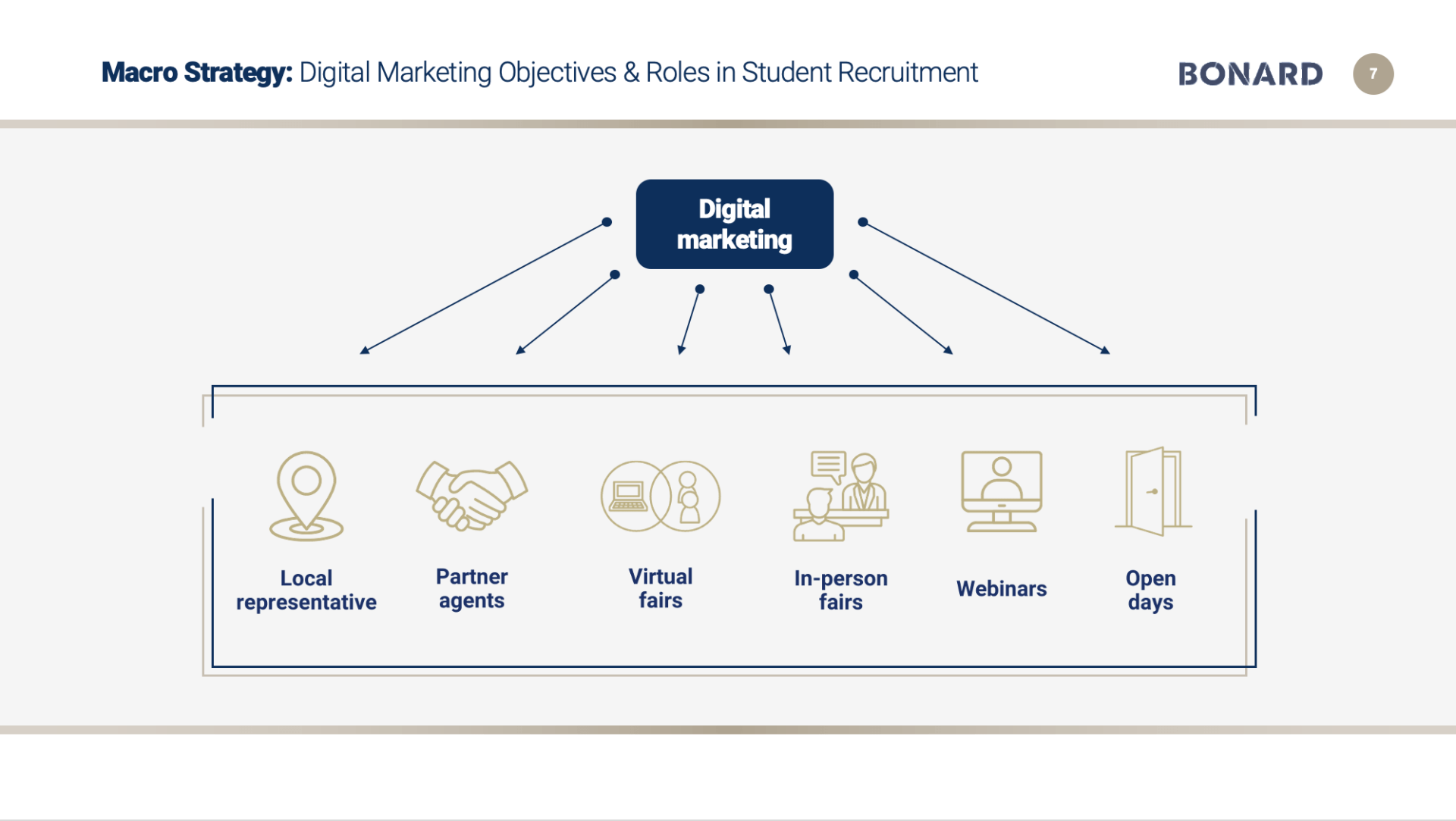 In addition to the strategies outlined above, SIOs can consider collaborating with digital marketing experts to further enhance their recruitment efforts.
In addition to the strategies outlined above, SIOs can consider collaborating with digital marketing experts to further enhance their recruitment efforts.
BONARD has experience in multiple digital marketing projects, including lead generation, event-driven and brand awareness campaigns, for different student institutions. By working with experts in digital marketing, recruitment teams can develop a customized digital marketing strategy that aligns with their specific needs and goals in any source market(s) worldwide.
In summary, digital marketing campaigns are a vital component in attracting international students to your institution. By utilizing the strategies discussed above and seeking guidance from digital marketing experts, SIOs can create impactful campaigns that effectively engage prospective students and help them choose the right institution for them.


